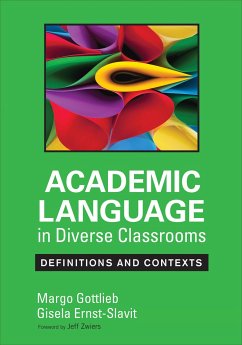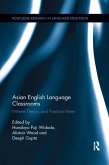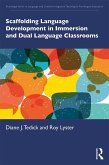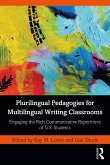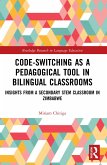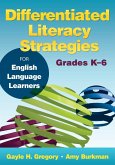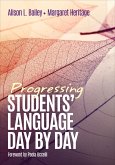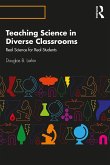- Broschiertes Buch
- Merkliste
- Auf die Merkliste
- Bewerten Bewerten
- Teilen
- Produkt teilen
- Produkterinnerung
- Produkterinnerung
Encapsulates the broad ideas of the series by presenting the evolving theory behind the construct of academic language, a definition and examples of each of its components, and a template for direct classroom application.
Andere Kunden interessierten sich auch für
![Asian English Language Classrooms Asian English Language Classrooms]() Asian English Language Classrooms65,99 €
Asian English Language Classrooms65,99 €![Scaffolding Language Development in Immersion and Dual Language Classrooms Scaffolding Language Development in Immersion and Dual Language Classrooms]() Diane J. TedickScaffolding Language Development in Immersion and Dual Language Classrooms39,99 €
Diane J. TedickScaffolding Language Development in Immersion and Dual Language Classrooms39,99 €![Plurilingual Pedagogies for Multilingual Writing Classrooms Plurilingual Pedagogies for Multilingual Writing Classrooms]() Plurilingual Pedagogies for Multilingual Writing Classrooms41,99 €
Plurilingual Pedagogies for Multilingual Writing Classrooms41,99 €![Code-Switching as a Pedagogical Tool in Bilingual Classrooms Code-Switching as a Pedagogical Tool in Bilingual Classrooms]() Miriam ChitigaCode-Switching as a Pedagogical Tool in Bilingual Classrooms42,99 €
Miriam ChitigaCode-Switching as a Pedagogical Tool in Bilingual Classrooms42,99 €![Differentiated Literacy Strategies for English Language Learners, Grades K-6 Differentiated Literacy Strategies for English Language Learners, Grades K-6]() Gayle H. GregoryDifferentiated Literacy Strategies for English Language Learners, Grades K-640,99 €
Gayle H. GregoryDifferentiated Literacy Strategies for English Language Learners, Grades K-640,99 €![Progressing Students′ Language Day by Day Progressing Students′ Language Day by Day]() Bailey, Alison L., Ed. DProgressing Students′ Language Day by Day25,99 €
Bailey, Alison L., Ed. DProgressing Students′ Language Day by Day25,99 €![Teaching Science in Diverse Classrooms Teaching Science in Diverse Classrooms]() Douglas B. LarkinTeaching Science in Diverse Classrooms63,99 €
Douglas B. LarkinTeaching Science in Diverse Classrooms63,99 €-
-
-
Encapsulates the broad ideas of the series by presenting the evolving theory behind the construct of academic language, a definition and examples of each of its components, and a template for direct classroom application.
Hinweis: Dieser Artikel kann nur an eine deutsche Lieferadresse ausgeliefert werden.
Hinweis: Dieser Artikel kann nur an eine deutsche Lieferadresse ausgeliefert werden.
Produktdetails
- Produktdetails
- Verlag: SAGE Publications Inc
- Seitenzahl: 256
- Erscheinungstermin: 22. April 2014
- Englisch
- Abmessung: 254mm x 178mm x 14mm
- Gewicht: 524g
- ISBN-13: 9781452234786
- ISBN-10: 1452234787
- Artikelnr.: 38267442
- Herstellerkennzeichnung
- Libri GmbH
- Europaallee 1
- 36244 Bad Hersfeld
- gpsr@libri.de
- Verlag: SAGE Publications Inc
- Seitenzahl: 256
- Erscheinungstermin: 22. April 2014
- Englisch
- Abmessung: 254mm x 178mm x 14mm
- Gewicht: 524g
- ISBN-13: 9781452234786
- ISBN-10: 1452234787
- Artikelnr.: 38267442
- Herstellerkennzeichnung
- Libri GmbH
- Europaallee 1
- 36244 Bad Hersfeld
- gpsr@libri.de
Margo Gottlieb, Ph.D., has been a bilingual teacher, coordinator, facilitator, consultant, and mentor across K-20 settings. Having worked with universities, organizations, governments, states, school districts, networks, and schools, Margo has co-constructed linguistic and culturally sustainable curriculum and reconceptualized classroom assessment, policy, and practice. As co-founder and lead developer of WIDA at the University of Wisconsin-Madison in 2003, Margo has helped design and contributed to all the editions of WIDA's English and Spanish language development standards frameworks and their derivative products. She has been appointed to national and state advisory boards, served as a Fulbright Senior Scholar, and was honored by the TESOL International Association in 2016 for her significant contribution to the field. An avid traveler, Margo has enjoyed keynoting and presenting across the United States, territories, and 25 countries. Having authored, co-authored, or co-edited over 100 publications, including 22 books, Margös 3rd edition of Assessing Multilingual Learners: Bridges to Empowerment (2024) and Collaborative Assessment for Multilingual Learners and Teachers: Pathways to Partnerships (with A. Honigsfeld, 2025) are the latest additions to her Corwin compendium.
Foreword
Preface
Acknowledgements
About the Authors
In the Beginning....
1. What is Academic Language?
The Role of Language in Schooling and Beyond
Different Registers
The Nature of Academic Language
Evolving Perspectives of Academic Language
Academic Language Versus Social Language Perspectives
Systemic Functional Linguistic Perspectives
Language Skills Perspectives
Sociocultural Perspectives
Language as Action Perspectives
Academic Language Learning as a Developmental Process
Considerations for Students with Disabilities
Oral and Written Languages
Oral Language as a Vehicle for Promoting Academic Language Development
Oral Language as a Bridge to Literacy
Multiliteracies and Multimodalities as Sources of Academic Language
Raising Awareness of Academic Language
Academic Language and Social Justice
For Further Thinking
2. What Are the Dimensions of Academic Language?
Identifying Academic Language Within and Across Content Areas
Analyzing Academic Language Within Discourse
Balance Between Informational and Literary Texts
Differences Between Nonfiction and Informational Texts
Examining Sentence-Level Structures
Language Functions as Expressions of Sentence-Level Meaning
Identifying Vocabulary--Words, Phrases, and Expressions
Development of Academic Vocabulary
Teaching Academic Vocabulary in Authentic Contexts Through Meaningful
Interactions
Vocabulary Instruction for English Language Learners
For Further Thinking
3. How Do Standards Define and Shape Academic Language Use?
The Impact of the New Standards on Shaping Academic Language
Bringing Standards Together: Content Learning Through Language and Language
Learning Through Content
Content and Language Learning for English Language Learners
The Impact of Standards in Shaping Grade-Level Language for Academic
Purposes
Academic Language Within Content Standards
Resources for ELLs for the New Content Standards
Examples of Academic Language in Content Standards
Academic Language in English Language Development/Proficiency Standards
Academic Language Use in Language Standards
The Impact of Home Language on Academic Language Development
Suggestions for Redefining Teaching and Learning Around Academic Language
Use
For Further Thinking
4. How is Academic Language Used in Content Areas Schoolwide?
Seeing Academic Language Throughout the School Day
Listening in the Music Classroom
Moving From a Physical Education Class to the Arts
Looking Into Mathematics Classrooms
Entering an English Language Arts Class
Visiting a Science Class
The Language of Science Textbooks
Exploring Academic Language in a Social Studies Class
The Specialized Language of Social Studies Texts
Effective Instruction in Content Classrooms Around a Unit of Learning
For Further Thinking
5. How Can Academic Language Be Integrated Into Instruction and Assessment?
Maintaining a Focus on Academic Language: A Historical Perspective
Planning a Unit of Learning Around Academic Language Use
Capitalizing on Linguistic and Cultural Resources
Deciding on a Theme for a Unit of Learning
Matching the Theme to Standards
Academic Language Use in Learning Targets and Differentiated Objectives
Infusing Academic Language Into Unit Targets and Differentiated Lesson
Objectives
Instructional Activities and Tasks
The Relationship Between Assessment and Instruction
Placement of Assessment Within a Curricular Framework
Assessment Across Lessons of a Unit: Measuring Standards and Learning
Targets
Assessment Within Lessons: Measuring Differentiated Objectives
Crafting Instructional Activities and Tasks
Reflecting on Teaching and Learning
Teacher Reflection
Student Reflection
For Further Thinking
6. How is Academic Language Situated in Curricular Design and Infused Into
Professional Learning?
A Theoretical Basis for Curricular Frameworks
Early Thinking on Curriculum
Recent Thinking on Curriculum
Conceptual Frameworks That Integrate Language and Content
The Value of an Integrated Curricular Framework for Diverse Schools and
Districts
A Curricular Framework That Features Academic Language Use
The Role of Professional Learning in Understanding and Promoting Academic
Language Use
Implementing Professional Learning: From Two Participants to District Level
Participation
Making School a Meaningful Experience for 21st Century Students
Culturally and Linguistically Responsive Teaching and Learning
Transformation of Schools
Promoting Academic Language for All Students and Teachers
Seeking Advocacy Within the Educational Community
For Further Thinking
At the End....
Resources
A. CCSS for Mathematics and Related Academic Language
B. Examples from the CCSS for English Language Arts of Related Academic
Language
C. A Curricular Framework Highlighting Academic Language
Glossary
References
Index
Preface
Acknowledgements
About the Authors
In the Beginning....
1. What is Academic Language?
The Role of Language in Schooling and Beyond
Different Registers
The Nature of Academic Language
Evolving Perspectives of Academic Language
Academic Language Versus Social Language Perspectives
Systemic Functional Linguistic Perspectives
Language Skills Perspectives
Sociocultural Perspectives
Language as Action Perspectives
Academic Language Learning as a Developmental Process
Considerations for Students with Disabilities
Oral and Written Languages
Oral Language as a Vehicle for Promoting Academic Language Development
Oral Language as a Bridge to Literacy
Multiliteracies and Multimodalities as Sources of Academic Language
Raising Awareness of Academic Language
Academic Language and Social Justice
For Further Thinking
2. What Are the Dimensions of Academic Language?
Identifying Academic Language Within and Across Content Areas
Analyzing Academic Language Within Discourse
Balance Between Informational and Literary Texts
Differences Between Nonfiction and Informational Texts
Examining Sentence-Level Structures
Language Functions as Expressions of Sentence-Level Meaning
Identifying Vocabulary--Words, Phrases, and Expressions
Development of Academic Vocabulary
Teaching Academic Vocabulary in Authentic Contexts Through Meaningful
Interactions
Vocabulary Instruction for English Language Learners
For Further Thinking
3. How Do Standards Define and Shape Academic Language Use?
The Impact of the New Standards on Shaping Academic Language
Bringing Standards Together: Content Learning Through Language and Language
Learning Through Content
Content and Language Learning for English Language Learners
The Impact of Standards in Shaping Grade-Level Language for Academic
Purposes
Academic Language Within Content Standards
Resources for ELLs for the New Content Standards
Examples of Academic Language in Content Standards
Academic Language in English Language Development/Proficiency Standards
Academic Language Use in Language Standards
The Impact of Home Language on Academic Language Development
Suggestions for Redefining Teaching and Learning Around Academic Language
Use
For Further Thinking
4. How is Academic Language Used in Content Areas Schoolwide?
Seeing Academic Language Throughout the School Day
Listening in the Music Classroom
Moving From a Physical Education Class to the Arts
Looking Into Mathematics Classrooms
Entering an English Language Arts Class
Visiting a Science Class
The Language of Science Textbooks
Exploring Academic Language in a Social Studies Class
The Specialized Language of Social Studies Texts
Effective Instruction in Content Classrooms Around a Unit of Learning
For Further Thinking
5. How Can Academic Language Be Integrated Into Instruction and Assessment?
Maintaining a Focus on Academic Language: A Historical Perspective
Planning a Unit of Learning Around Academic Language Use
Capitalizing on Linguistic and Cultural Resources
Deciding on a Theme for a Unit of Learning
Matching the Theme to Standards
Academic Language Use in Learning Targets and Differentiated Objectives
Infusing Academic Language Into Unit Targets and Differentiated Lesson
Objectives
Instructional Activities and Tasks
The Relationship Between Assessment and Instruction
Placement of Assessment Within a Curricular Framework
Assessment Across Lessons of a Unit: Measuring Standards and Learning
Targets
Assessment Within Lessons: Measuring Differentiated Objectives
Crafting Instructional Activities and Tasks
Reflecting on Teaching and Learning
Teacher Reflection
Student Reflection
For Further Thinking
6. How is Academic Language Situated in Curricular Design and Infused Into
Professional Learning?
A Theoretical Basis for Curricular Frameworks
Early Thinking on Curriculum
Recent Thinking on Curriculum
Conceptual Frameworks That Integrate Language and Content
The Value of an Integrated Curricular Framework for Diverse Schools and
Districts
A Curricular Framework That Features Academic Language Use
The Role of Professional Learning in Understanding and Promoting Academic
Language Use
Implementing Professional Learning: From Two Participants to District Level
Participation
Making School a Meaningful Experience for 21st Century Students
Culturally and Linguistically Responsive Teaching and Learning
Transformation of Schools
Promoting Academic Language for All Students and Teachers
Seeking Advocacy Within the Educational Community
For Further Thinking
At the End....
Resources
A. CCSS for Mathematics and Related Academic Language
B. Examples from the CCSS for English Language Arts of Related Academic
Language
C. A Curricular Framework Highlighting Academic Language
Glossary
References
Index
Foreword
Preface
Acknowledgements
About the Authors
In the Beginning....
1. What is Academic Language?
The Role of Language in Schooling and Beyond
Different Registers
The Nature of Academic Language
Evolving Perspectives of Academic Language
Academic Language Versus Social Language Perspectives
Systemic Functional Linguistic Perspectives
Language Skills Perspectives
Sociocultural Perspectives
Language as Action Perspectives
Academic Language Learning as a Developmental Process
Considerations for Students with Disabilities
Oral and Written Languages
Oral Language as a Vehicle for Promoting Academic Language Development
Oral Language as a Bridge to Literacy
Multiliteracies and Multimodalities as Sources of Academic Language
Raising Awareness of Academic Language
Academic Language and Social Justice
For Further Thinking
2. What Are the Dimensions of Academic Language?
Identifying Academic Language Within and Across Content Areas
Analyzing Academic Language Within Discourse
Balance Between Informational and Literary Texts
Differences Between Nonfiction and Informational Texts
Examining Sentence-Level Structures
Language Functions as Expressions of Sentence-Level Meaning
Identifying Vocabulary--Words, Phrases, and Expressions
Development of Academic Vocabulary
Teaching Academic Vocabulary in Authentic Contexts Through Meaningful
Interactions
Vocabulary Instruction for English Language Learners
For Further Thinking
3. How Do Standards Define and Shape Academic Language Use?
The Impact of the New Standards on Shaping Academic Language
Bringing Standards Together: Content Learning Through Language and Language
Learning Through Content
Content and Language Learning for English Language Learners
The Impact of Standards in Shaping Grade-Level Language for Academic
Purposes
Academic Language Within Content Standards
Resources for ELLs for the New Content Standards
Examples of Academic Language in Content Standards
Academic Language in English Language Development/Proficiency Standards
Academic Language Use in Language Standards
The Impact of Home Language on Academic Language Development
Suggestions for Redefining Teaching and Learning Around Academic Language
Use
For Further Thinking
4. How is Academic Language Used in Content Areas Schoolwide?
Seeing Academic Language Throughout the School Day
Listening in the Music Classroom
Moving From a Physical Education Class to the Arts
Looking Into Mathematics Classrooms
Entering an English Language Arts Class
Visiting a Science Class
The Language of Science Textbooks
Exploring Academic Language in a Social Studies Class
The Specialized Language of Social Studies Texts
Effective Instruction in Content Classrooms Around a Unit of Learning
For Further Thinking
5. How Can Academic Language Be Integrated Into Instruction and Assessment?
Maintaining a Focus on Academic Language: A Historical Perspective
Planning a Unit of Learning Around Academic Language Use
Capitalizing on Linguistic and Cultural Resources
Deciding on a Theme for a Unit of Learning
Matching the Theme to Standards
Academic Language Use in Learning Targets and Differentiated Objectives
Infusing Academic Language Into Unit Targets and Differentiated Lesson
Objectives
Instructional Activities and Tasks
The Relationship Between Assessment and Instruction
Placement of Assessment Within a Curricular Framework
Assessment Across Lessons of a Unit: Measuring Standards and Learning
Targets
Assessment Within Lessons: Measuring Differentiated Objectives
Crafting Instructional Activities and Tasks
Reflecting on Teaching and Learning
Teacher Reflection
Student Reflection
For Further Thinking
6. How is Academic Language Situated in Curricular Design and Infused Into
Professional Learning?
A Theoretical Basis for Curricular Frameworks
Early Thinking on Curriculum
Recent Thinking on Curriculum
Conceptual Frameworks That Integrate Language and Content
The Value of an Integrated Curricular Framework for Diverse Schools and
Districts
A Curricular Framework That Features Academic Language Use
The Role of Professional Learning in Understanding and Promoting Academic
Language Use
Implementing Professional Learning: From Two Participants to District Level
Participation
Making School a Meaningful Experience for 21st Century Students
Culturally and Linguistically Responsive Teaching and Learning
Transformation of Schools
Promoting Academic Language for All Students and Teachers
Seeking Advocacy Within the Educational Community
For Further Thinking
At the End....
Resources
A. CCSS for Mathematics and Related Academic Language
B. Examples from the CCSS for English Language Arts of Related Academic
Language
C. A Curricular Framework Highlighting Academic Language
Glossary
References
Index
Preface
Acknowledgements
About the Authors
In the Beginning....
1. What is Academic Language?
The Role of Language in Schooling and Beyond
Different Registers
The Nature of Academic Language
Evolving Perspectives of Academic Language
Academic Language Versus Social Language Perspectives
Systemic Functional Linguistic Perspectives
Language Skills Perspectives
Sociocultural Perspectives
Language as Action Perspectives
Academic Language Learning as a Developmental Process
Considerations for Students with Disabilities
Oral and Written Languages
Oral Language as a Vehicle for Promoting Academic Language Development
Oral Language as a Bridge to Literacy
Multiliteracies and Multimodalities as Sources of Academic Language
Raising Awareness of Academic Language
Academic Language and Social Justice
For Further Thinking
2. What Are the Dimensions of Academic Language?
Identifying Academic Language Within and Across Content Areas
Analyzing Academic Language Within Discourse
Balance Between Informational and Literary Texts
Differences Between Nonfiction and Informational Texts
Examining Sentence-Level Structures
Language Functions as Expressions of Sentence-Level Meaning
Identifying Vocabulary--Words, Phrases, and Expressions
Development of Academic Vocabulary
Teaching Academic Vocabulary in Authentic Contexts Through Meaningful
Interactions
Vocabulary Instruction for English Language Learners
For Further Thinking
3. How Do Standards Define and Shape Academic Language Use?
The Impact of the New Standards on Shaping Academic Language
Bringing Standards Together: Content Learning Through Language and Language
Learning Through Content
Content and Language Learning for English Language Learners
The Impact of Standards in Shaping Grade-Level Language for Academic
Purposes
Academic Language Within Content Standards
Resources for ELLs for the New Content Standards
Examples of Academic Language in Content Standards
Academic Language in English Language Development/Proficiency Standards
Academic Language Use in Language Standards
The Impact of Home Language on Academic Language Development
Suggestions for Redefining Teaching and Learning Around Academic Language
Use
For Further Thinking
4. How is Academic Language Used in Content Areas Schoolwide?
Seeing Academic Language Throughout the School Day
Listening in the Music Classroom
Moving From a Physical Education Class to the Arts
Looking Into Mathematics Classrooms
Entering an English Language Arts Class
Visiting a Science Class
The Language of Science Textbooks
Exploring Academic Language in a Social Studies Class
The Specialized Language of Social Studies Texts
Effective Instruction in Content Classrooms Around a Unit of Learning
For Further Thinking
5. How Can Academic Language Be Integrated Into Instruction and Assessment?
Maintaining a Focus on Academic Language: A Historical Perspective
Planning a Unit of Learning Around Academic Language Use
Capitalizing on Linguistic and Cultural Resources
Deciding on a Theme for a Unit of Learning
Matching the Theme to Standards
Academic Language Use in Learning Targets and Differentiated Objectives
Infusing Academic Language Into Unit Targets and Differentiated Lesson
Objectives
Instructional Activities and Tasks
The Relationship Between Assessment and Instruction
Placement of Assessment Within a Curricular Framework
Assessment Across Lessons of a Unit: Measuring Standards and Learning
Targets
Assessment Within Lessons: Measuring Differentiated Objectives
Crafting Instructional Activities and Tasks
Reflecting on Teaching and Learning
Teacher Reflection
Student Reflection
For Further Thinking
6. How is Academic Language Situated in Curricular Design and Infused Into
Professional Learning?
A Theoretical Basis for Curricular Frameworks
Early Thinking on Curriculum
Recent Thinking on Curriculum
Conceptual Frameworks That Integrate Language and Content
The Value of an Integrated Curricular Framework for Diverse Schools and
Districts
A Curricular Framework That Features Academic Language Use
The Role of Professional Learning in Understanding and Promoting Academic
Language Use
Implementing Professional Learning: From Two Participants to District Level
Participation
Making School a Meaningful Experience for 21st Century Students
Culturally and Linguistically Responsive Teaching and Learning
Transformation of Schools
Promoting Academic Language for All Students and Teachers
Seeking Advocacy Within the Educational Community
For Further Thinking
At the End....
Resources
A. CCSS for Mathematics and Related Academic Language
B. Examples from the CCSS for English Language Arts of Related Academic
Language
C. A Curricular Framework Highlighting Academic Language
Glossary
References
Index

